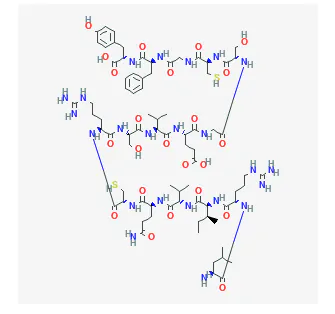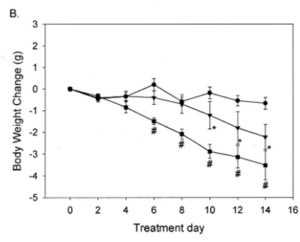What Is hGH Fragment 176-191?
hGH Fragment 176-191, often referred to as frag 176-191, is a lab-created peptide derived from (hGH), an amino acid sequence of human growth hormone. This peptide is renowned for its potential lipolytic (fat-burning) properties, making it a subject of interest in research related to weight loss and obesity. It is believed to specifically target adipose fat, promoting the breakdown of fat cells while minimizing the release of glucose. Additionally, frag 176-191 has been investigated for its potential anticancer effects and its ability to promote lean body mass without affecting blood sugar levels.
hGH Fragment 176-191 Peptide Structure

Source: PubChem
- Sequence: Tyr-Leu-Arg-Ile-Val-Gln-Cys-Arg-Ser-Val-Glu-Gly-Ser-Cys-Gly-Phe
- Molecular Formula: C78H125N23O23S2
- Molecular Weight: 1812.12 g/mol
- CAS Number: 66004-57-7
hGH Fragment 176-191 Effects
1. Lowers Blood Sugar
hGH Fragment 176-191 is believed to affect blood sugar levels by targeting adipose fat rather than impacting glucose metabolism directly. Studies suggest that this peptide promotes lipolysis, the breakdown of fat stores, while inhibiting lipogenesis and forming new fat. By targeting fat cells, it may encourage the release of stored energy in the form of fatty acids, potentially leading to a reduction in adiposity without significantly affecting blood sugar levels.
Studies have suggested that this peptide may enhance insulin sensitivity, which could benefit individuals with diabetes by improving their ability to regulate blood sugar levels. Additionally, hGH fragment 176-191 may impact glucose uptake, potentially affecting the body's utilization of glucose.
2. Fat Burning And Weight Loss
hGH Fragment 176-191 has garnered attention for its potential to contribute to fat burning and weight loss. It is believed to regulate fat metabolism, promoting the breakdown of fat stores, a process known as lipolysis. By targeting adipose fat cells and enhancing the burning of fat, frag 176-191 may play a role in supporting weight reduction by increasing energy expenditure. Moreover, it's noteworthy that this peptide's ability to promote fat loss without significantly affecting insulin makes it an intriguing candidate for further research and development in weight management.

Body weight in genetically obese mice after two weeks of treatment with a single daily dose of fragment 176-191
Source: Oxford Academic

Effect of saline (control), fragment 176-191, and hGH on white adipose tissue mass in obese mice over 14 days
Source: Oxford Academic
3. Promotes Cartilage Regeneration
Studies have suggested that this synthetic peptide sequence may offer an opportunity for qualified researchers to explore the field of cartilage regeneration. While the specific mechanisms it encourages cartilage regeneration may vary, the peptide has been associated with fat loss, lower blood sugar levels, and potential impacts on tissue repair and regeneration.
Fragment 176-191 Safety Studies
The safety profile of Fragment 176–191, also known as AOD 9604, has been the subject of various research studies. Research has indicated that AOD 9604, a synthetic version of human growth hormone (HGH) and a revised version of hGH fragment 176-191 with a disulfide bridge, has undergone thorough clinical studies to assess its safety and efficacy.
Furthermore, studies have explored the effects of oral administration of a synthetic fragment of human growth hormone on lipid metabolism, suggesting the need for safe and effective pharmacotherapy for treating obesity. Additionally, ongoing research and practice in the field of occupational safety have underscored the relevance of ensuring a safe work environment, reflecting the broader considerations for safety in various research domains.
Fragment 176-191 Dosage
When it comes to the dosage of HGH Fragment 176-191, it's crucial to note that peptide dosages can vary based on individual factors such as body weight, tolerance, and desired outcomes. However, a commonly referenced HGH Fragment 176-191 dosage is around 250-500 mcg per day. This dosage is generally divided into two administrations, one in the morning and the other in the late afternoon or evening.
Article Author
The above literature was researched, edited and organized by Dr. Logan, M.D. Dr. Logan holds a doctorate degree from Case Western Reserve University School of Medicine and a B.S. in molecular biology.
Scientific Journal Article
Frank NG, M.D. is one of the leading scientists discovering how both AOD9604 and Fragment 176-191 function. He extensively studied their effects on lipid metabolism in obese mice, fat oxidation, weight loss, oral digestion, glucose transport, and hyperglycemia. He has over 64 publications and studies at the Department of Biochemistry and Molecular Biology -- Monash University, Australia.
Frank NG, M.D. is being referenced as one of the leading scientists involved in the research and development of Epitalon. In no way is this doctor/scientist endorsing or advocating the purchase, sale, or use of this product for any reason. There is no affiliation or relationship, implied or otherwise, between Peptide Shop and this doctor. The purpose of citing the doctor is to acknowledge, recognize, and credit the exhaustive research and development efforts conducted by the scientists studying this peptide. Frank NG, M.D. is listed in [1] [2] and [4] under the referenced citations.
Referenced Citations
- F. M. Ng and J. Bornstein, “Hyperglycemic action of synthetic C-terminal fragments of human growth hormone,” Am. J. Physiol., vol. 234, no. 5, pp. E521-526, May 1978.
- M. Heffernan et al., “The Effects of Human GH and Its Lipolytic Fragment (AOD9604) on Lipid Metabolism Following Chronic Treatment in Obese Mice andβ 3-AR Knock-Out Mice,” Endocrinology, vol. 142, no. 12, pp. 5182–5189, Dec. 2001.
- R. Ferrer-Lorente, C. Cabot, J.-A. Fernández-López, and M. Alemany, “Combined effects of oleoyl-estrone and a beta3-adrenergic agonist (CL316,243) on lipid stores of diet-induced overweight male Wistar rats,” Life Sci., vol. 77, no. 16, pp. 2051–2058, Sep. 2005.
- F. M. Ng, J. Sun, L. Sharma, R. Libinaka, W. J. Jiang, and R. Gianello, “Metabolic studies of a synthetic lipolytic domain (AOD9604) of human growth hormone,” Horm. Res., vol. 53, no. 6, pp. 274–278, 2000.
- H. Stier, E. Vos, and D. Kenley, “Safety and Tolerability of the Hexadecapeptide AOD9604 in Humans,” J. Endocrinol. Metab., vol. 3, no. 1–2, pp. 7-15–15, Apr. 2013.
- M. A. Heffernan et al., “Increase of fat oxidation and weight loss in obese mice caused by chronic treatment with human growth hormone or a modified C-terminal fragment,” Int. J. Obes. Relat. Metab. Disord. J. Int. Assoc. Study Obes., vol. 25, no. 10, pp. 1442–1449, Oct. 2001.
- D. R. Kwon and G. Y. Park, “Effect of Intra-articular Injection of AOD9604 with or without Hyaluronic Acid in Rabbit Osteoarthritis Model,” Ann. Clin. Lab. Sci., vol. 45, no. 4, pp. 426–432, Jul. 2015.
ALL ARTICLES AND PRODUCT INFORMATION PROVIDED ON THIS WEBSITE ARE FOR INFORMATONAL AND EDUCATIONAL PURPOSES ONLY.
The products offered on this website are furnished for in-vitro studies only. In-vitro studies (Latin: in glass) are performed outside of the body. These products are not medicines or drugs and have not been approved by the FDA to prevent, treat or cure any medical condition, ailment or disease. Bodily introduction of any kind into humans or animals is strictly forbidden by law.
Source:
https://pubmed.ncbi.nlm.nih.gov/645904/
https://www.ncbi.nlm.nih.gov/pmc/articles/PMC9249349/
https://www.sciencedirect.com/science/article/pii/S2452199X22005230
https://www.sciencedirect.com/science/article/abs/pii/S0141813020353356
https://pubmed.ncbi.nlm.nih.gov/35783198/


